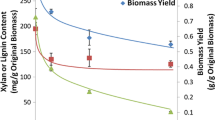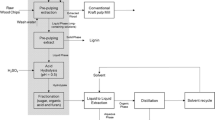Abstract
The isolation of non-cellulosic heteropolysaccharides (HetPS) from barley husks (Hordeum spp.) and yellow poplar wood chips (Liriodendron tulipifera) was accomplished using mild steam explosion followed by extraction with water and ultrafiltration. The generally low yields, low purity, and low degree of polymerization (DP) improved when the HetPS were isolated following either alkali extraction of hammermilled or disk-refined biomass, or from holocellulose preparations generated by the conventional chlorite method or by organosolv delignification. Several purification methods were examined including precipitation using methanol; treatment with hydrogen peroxide (H2O2) or activated carbon (C) followed by precipitation with methanol; and H2O2-treatment followed by ultrafiltration. The isolation protocols were judged based on product yield, xylan content, and DP. The results indicate that, although steam explosion is effective in removing HetPS from the fiber source, virtually none remain in polymeric form. By contrast, alkali extraction succeeds in separating polymeric HetPS from the fiber source; and HetPS purity increases and polydispersity decreases with fiber prehydrolysis and delignification. Significant processing difficulties were attributed to the intimate association of HetPS with lignin which was effectively disrupted by acid-catalyzed pretreatment and treatment with H2O2. Ultrafiltration of H2O2-treated HetPS solutions represents the best procedure for isolating a xylan-rich polymer in high yield, with high DP and with high purity. Aqueous HetPS solutions can be spray- or freeze-dried into powderous products.
Similar content being viewed by others
References
Aman, P. (1993) Composition and structure of cell wall polysaccharides in forages. In Forage Cell Wall Structure and Digestibility. H. G. Jung, D. R. Buxton, R. D. Hatfield, J. Ralph (eds). Chap: 8, ASA, Inc., Madison, WI, pp. 183-199.
Anderson, E., Seeley, M., Stewart, W. T., Reed, J. C. and Westerbeke, D. (1940) The origin and composition of the hemicelluloses obtained from hardwoods. J. Biol. Chem. 135, 189-198.
Aspinall, G. O. (1959) Structural chemistry of the hemicelluloses. Advan. Carbohydr. Chem. 14, 429-468.
Aspinall, G. O. and Mahomed, R. S. (1954) The constitution of a wheat-straw xylan. J. Chem. Soc. 1731-1734.
Avellar, B. K. and Glasser, W. G. (1998) Steam-assisted biomass fractionation. I. Process considerations and economic evaluation. Biomass and Bioenergy 14(3), 205-218.
Avignon, G., Jaeggle, W., Steinmuller, H. and Lackner, K. (1990a) Combined process for thermally and chemically treating lignocellulose-containing biomass and for producing furfural. U. S. Patent # 4,916,242.
Avignon, G., Jaeggle, W., Steinmuller, H. and Steiner, T. (1990b) Combined process for thermally and chemically treating lignocellulose containing biomass and for producing furfural and cellulose-containing fiber masses. U. S. Patent # 4,971,657.
Barnett, E. R., Dikeman, R., Pantaleone, D. P., Liao, S. Y. and Gill, J. (1989) Water soluble bulking agents. Eur. Patent EP 0,301,440 A1.
Buckl, H. and Fahn, R. (1979) Process for the two-stage composition of the hemicelluloses of xylan-containing natural products for the purpose of obtaining xylose. U.S. Patent # 4,137,395.
Chinen, I. and Sadoyama, K. (1989) Method for recovering hemicellulose from bagasse. Japanese Patent JP 89 40, 502.
Dietrichs, H. H., Sinner, M., Opderbeck, F. and Brachthauser, K. H. (1980) Process for obtaining xylan and fibrin from vegetable raw material containing xylan. U.S. Patent # 4,181,796.
Doner, L. M. and Hicks, K. (1997) Isolation of hemicellulose from corn fibre by alkaline hydrogen peroxide extraction. Cereal Chem. 74, 176-181.
Ehrenthal, I., Montgomery, R. and Smith, F. (1954) The carbohydrates of gramineae. II. The constitution of the hemicelluloses of wheat straw and corn cobs. J. Amer. Chem. Soc. 76, 5509-5514.
Fang, J. M., Sun, R. C. and Tomkinson, J. (2000) Isolation and characterization of hemicelluloses and cellulose from rye straw by alkaline peroxide extraction. Cellulose 7(1), 1-21.
Fang, J. M., Sun, R. C., Salisbury, D., Fowler, P. and Tomkinson, J. (1999) Comparative study of hemicelluloses and lignin from wheat straw by alkali and hydrogen peroxide extractions. Polym. Degrad. Stabil. 66, 423-432.
Glasser, W. G., Jain, R. K. and Sjostedt, M. (1995) Thermoplastic pentosan-rich polysaccharides from biomass, Patent # 5,430,142.
Glasser, W. G. (1991) Research with biopolymers from steam-exploded biomass. In Proceedings: 6th International Symposium on Wood and Pulping Chemistry, Appita 1, 319-322.
Glaudemans, C. P. J. and Timell, T. E. (1958) The polysaccharides of white birch (Betula papyrifera). IV. The constitution of the hemicellulose. J. Amer. Chem. Soc. 80, 1209-1213.
Ibrahim, M. and Glasser, W. G. Steam-assisted biomass fractionation. III. A quantitative evaluation of the 'Clean Fractionation' concept. Bioresource Technology, (1991) 70, 181-192.
Meier, H. (1962) Chemical and morphological aspects of the fine structure of wood. Pure Appl. Chem. 5, 37-52.
Juslin, M. and Paronen, P. J. (1984) Xylan-a possible filler and disintegrant for tablets. Pharm. Pharmacol. 36, 256-257.
Kaar, W. E., Cool, L. G., Merriman, M. M. and Brink, D. L. (1991a) The complete analysis of wood polysaccharides using HPLC. J. Wood Chem. Technol. 11, 447-463.
Kaar, W. E. and Brink, D. L. (1991b) Simplified analysis of acid soluble lignin.J. Wood Chem. Technol. 11, 465-477.
Kaar, W. E. and Brink, D. L. (1991c) Summative analysis of nine common north American woods. J. Wood Chem. Technol. 11, 479-494.
Magerstaedt, M., Meichsner, C., Schlingmann, M., Schrinner, E., Walch, A., Wiesner, M. and Winkler, I. (1991) Preparation of polysaccharide ester sulfates as HIV inhibitor. Ger. Patent DE 3,921,761 A1.
O'Dwyer, M. H. (1926) LXXXVI. The hemicelluloses. Part IV. The hemicelluloses of beech wood. Biochem. J. 20, 656-664.
O'Dwyer, M. H. (1923) LXI. The hemicelluloses. III. The hemicellulose of American white oak. Biochem. J. 17, 501-509.
Okamoto, Y., Kawashima, M. and Hatada, K. (1984) Useful chiral packing materials for high-performance liquid chromatographic resolution of enantiomers: phenylcarbamates of polysaccharides coated on silica gel. J. Amer. Chem. Soc. 106, 5357-5359.
Overend, R. P. and Chornet E. (1089) Steam and aqueous pretreatments: Are they prehydrolyses. In Wood Processing and Utilization. J. F. Kennedy, G. O. Phillips, P. A. Williams (eds). Ellis Horwood: Chichester, pp. 395-400.
Overend, R. P. and Chornet, E. (1987) Fractionation of lignocellulosics by steam-aqueous pretreatments. Phil. Trans. R. Soc. Lond. A321, 523-536.
Shimizu, K., Sudo, K., Ono, H. and Fujii, T. (1989) Total utilization of wood components by steam explosion pretreatment. In Wood Processing and Utilization. J. F. Kennedy, G. O. Phillips, P. A. Williams (eds). Ellis Horwood, Chichester, pp. 407-412.
Sun, R. C., Lawther, J. M. and Banks, W. B. (1996) Fractional and structural characterization of wheat straw hemicelluloses. Carbohydr. Polym. 29, 325-331.
Timell, T. E. (1964) Wood hemicelluloses: Part I. Advan. Carbohyd. Chem. 19, 247-302.
Timell, T. E. (1965) Wood hemicelluloses: Part II. Advan. Carbohyd. Chem. 20, 409-482.
Whistler, R. L. (1950) Xylan. Advan. Carbohyd. Chem. 5, 269-290.
Wise, L. E., Murphy, M. and D'Addieco, A. A. (1946) Chlorite holocellulose, its fractionation and bearing on summative wood analysis and on studies on the hemicelluloses. Paper Trade J. 122(2), 35-43.
Wright, R. S. and Glasser, W. G. (1998) Steam-assisted biomass fractionation. II. Fractionation behavior of various biomass resources. Biomass and Bioenergy 14(3), 219-235.
Zhuang, Q. and Vidal, P. F. (1997) Hemicelluloses solubilization from Populus Tremuloides via steam explosion and characterization of the water-soluble fraction. Cellulose Chem. Technol. 31, 37-49.
Author information
Authors and Affiliations
Rights and permissions
About this article
Cite this article
Glasser, W.G., Kaar, W.E., Jain, R.K. et al. Isolation options for non-cellulosic heteropolysaccharides (HetPS). Cellulose 7, 299–317 (2000). https://doi.org/10.1023/A:1009277009836
Issue Date:
DOI: https://doi.org/10.1023/A:1009277009836




